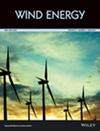大气稳定性对动态尾流曲流模型的影响,应用于两台12mw浮式风力机
IF 3.3
3区 工程技术
Q3 ENERGY & FUELS
引用次数: 0
摘要
当前的浮式风力涡轮机(FWTs)全球分析工具没有考虑大气稳定性和邻近涡轮机尾迹的综合影响。本研究使用中保真度动态尾流弯曲模型,以及基于稳定、中性和不稳定大气条件产生的湍流风场,研究了两个半潜式fwt的低频整体响应内容,这些fwt相隔8个转子直径。采用了基于Kaimal谱和指数相干模型、Mann谱张量模型和基于时间序列输入的湍流模型的来风场。这些模型各自的输入参数被拟合到高保真大涡模拟数据中。在不稳定的、低于额定的条件下,弯曲导致下风涡轮机偏航标准偏差的增加几乎是上风涡轮机的三倍。赤字和向上的尾流偏转影响平均俯仰和偏航,特别是在低于额定风速的情况下。顺风机的平均俯仰减小到顺风机平均俯仰的一半,而平均偏航由于剪切作用的增强而改变了方向。曲流对结构载荷的影响对下游涡轮塔顶偏航力矩的标准差影响最大,比逆风涡轮增大2.2倍以上。基于这些发现,大气稳定性影响尾流赤字和蜿蜒,而尾流赤字和蜿蜒反过来又对漂浮式风力涡轮机的低频整体运动和结构响应产生深远影响。本文章由计算机程序翻译,如有差异,请以英文原文为准。
Effect of atmospheric stability on the dynamic wake meandering model applied to two 12 MW floating wind turbines
Abstract Current global analysis tools for floating wind turbines (FWTs) do not account for the combined effects of atmospheric stability and wakes from neighboring turbines. This work uses the mid‐fidelity dynamic wake meandering model, together with turbulent wind fields generated based on stable, neutral, and unstable atmospheric conditions, to study the low‐frequency content of the global responses of two semisubmersible FWTs separated by eight rotor diameters. Incoming wind fields based on the Kaimal spectrum and exponential coherence model, the Mann spectral tensor model, and a time‐series input‐based turbulence model are used. The respective input parameters for these models are fitted to high‐fidelity large eddy simulation data. In unstable, below‐rated conditions, meandering leads to an increase in the yaw standard deviation of the downwind turbine of almost three times larger than the upwind turbine. Deficit and the upwards wake deflection affect the mean pitch and yaw, especially for the below‐rated wind speed scenario. The mean pitch of the downwind turbine is reduced up to half the mean pitch value of the upwind turbine, whereas the mean yaw changes direction due to the enhanced effect of shear. The effect of meandering on the structural loading is highest on the standard deviation of the tower‐top yaw moment of the downstream turbine, which increases more than 2.2 times compared to the upwind turbine value. Based on these findings, atmospheric stability affects wake deficit and meandering which in turn have a profound effect on the low‐frequency global motions and structural response of floating wind turbines.
求助全文
通过发布文献求助,成功后即可免费获取论文全文。
去求助
来源期刊

Wind Energy
工程技术-工程:机械
CiteScore
9.60
自引率
7.30%
发文量
0
审稿时长
6 months
期刊介绍:
Wind Energy offers a major forum for the reporting of advances in this rapidly developing technology with the goal of realising the world-wide potential to harness clean energy from land-based and offshore wind. The journal aims to reach all those with an interest in this field from academic research, industrial development through to applications, including individual wind turbines and components, wind farms and integration of wind power plants. Contributions across the spectrum of scientific and engineering disciplines concerned with the advancement of wind power capture, conversion, integration and utilisation technologies are essential features of the journal.
 求助内容:
求助内容: 应助结果提醒方式:
应助结果提醒方式:


